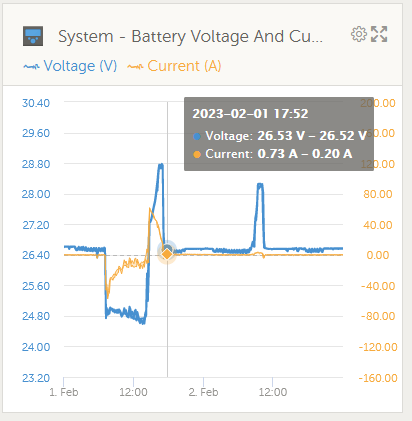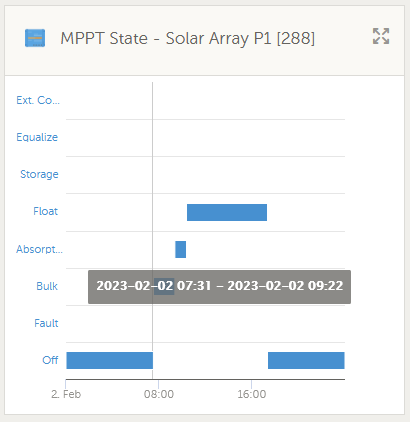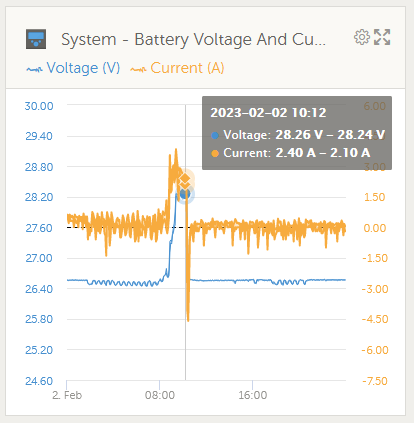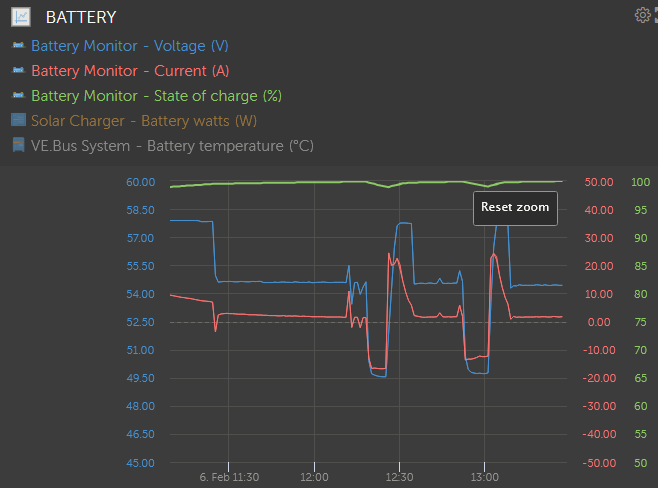Hi,
This isn't my first post but it is my first question (in the form of a request). See the bottom of this post for the request specifics. I have seen questions regarding MPPT daily bulk charging but haven't seen either a usable answer or a specific request to provide tooling for the daily (re-bulk) charge cycling to be controlled by the user so... Here goes:
The desired action is for the MPPT to only start a bulk charge cycle when the battery being maintained drop below the re-bulk voltage. This could easily be introduced as a control where the user/owner can select daily re-bulk (and voltage based re-bulk) or voltage based re-bulk only. I may be one of only a few users that think this way but there really isn't any benefit for a battery to be bulk charged daily if the battery voltage doesn't drop below the re-bulk offset voltage. I recognize this controller has many functions but this method of charging is potentially harmful to batteries.
When charging is controlled solely by the MPPT, there may be cases where re-bulk charging every time the sun comes up and a new PV voltage is detected with the assumption the battery voltage doesn't matter at that point (I still don't understand but...) When the battery voltage is managed by an outside charger all night (in other words, the float voltage is kept up all night long by a separate charging device), please don't force my batteries to be subjected to a bulk charge voltage every single day. Let me paint a clearer picture:
I live in northwest Washington (USA) where the sun rarely comes out in the winter months and when it does, it isn't strong enough to maintain a decent PV charge but the sun can help keep the batteries from becoming completely exhausted if there is a power failure. Let's assume this system is on a boat so the PVs cannot be oriented toward the sun to capture the full power of what little sun there is (no tracking devices). When the sun comes up high enough to wake up the MPPTs, they start bulk charging until that bulk voltage is reached, then attempt absorption charging until the timer expires. This means at this time of year, at least 3 hours of unnecessary charging takes place (more on a cloudy day where the bulk voltage is more difficult to reach due to cloud cover) and the batteries are subjected to voltages they don't need (and really shouldn't see) which generates unnecessary heat and that heat boils off precious moisture that has to be replaced in a wasted maintenance routine.
I have a good example from Feb 02. Around 07:40, the PVs have just enough sun to start producing some sort of power:
 It is probably worth mentioning the battery voltage was between 26.4 and 26.6 from the end of the MPPT charge cycle the day before until the start of this cycle:
It is probably worth mentioning the battery voltage was between 26.4 and 26.6 from the end of the MPPT charge cycle the day before until the start of this cycle:

The long cycle the day before was due to the shore power chargers being turned off for the day. Back to the 02/02/23: The charging mode is confirmed by the MPPTs:

Once the bulk voltage is satisfied, the absorption phase starts and last until about 10:20. The effect at the battery is a daily voltage that is not only unnecessary but will eventually dry out the batteries:

Charging a charged battery is simply undesirable and has nothing but bad effects on the batteries. It also takes all the affected charging equipment through an unnecessary heat cycle which will prematurely wear (or burn) out panels, MPPTs, and batteries.
Making adjustments to bulk and absorption settings will negatively affect charging when the batteries are not charged (i.e. not on shore power and at a safe float voltage all night) and not a good idea. I have considered turning off the PVs for the winter but that negates the safety factor in the case of a shore power outage.
Why would a new charge cycle start just because the PV voltage drops below a voltage that isn't configurable? Until the battery voltage drops below the re-bulk setting, I don't want my batteries hit with a bulk charge voltage every day.
There is a fairly easy answer (from my perspective) but it requires a little work, MPPT firmware, I imagine. Two solutions come to mind (both in firmware/software):
- Add a configurable toggle so the user/owner has the ability to turn off the "daily" charge cycling.
- Add a configurable charge cycle threshold for the PV voltage so it can be set to a voltage that the PV cannot reach (i.e. -0.1V) so the re-bulk setting takes precedence over the "daily" charge cycle.

